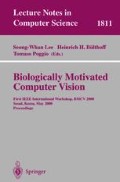Abstract
Motivated by the full field of view of insect eyes and their fast and accurate estimation of egomotion, we constructed a system of cameras to take advantage of the full field of view (FOV) constraints that insects use. In this paper, we develop a new ego-motion algorithm for a rigidly mounted set of cameras undergoing arbitrary rigid motion. This egomotion algorithm combines the unambiguous components of the motion computed by each separate camera. We prove that the cyclotorsion is resistant to errors and show this empirically. We show how to calibrate the system with two novel algorithms, one using secondary cameras and one using self calibration. Given this system calibration, the new 3D motion algorithm first computes the rotation and then the 3D translation. We apply this algorithm to a camera system constructed with four rigidly mounted synchronized cameras pointing in various directions and present motion estimation results at www.cfar.umd.edu/~pbaker/argus.html.
Access this chapter
Tax calculation will be finalised at checkout
Purchases are for personal use only
Preview
Unable to display preview. Download preview PDF.
References
G. Adiv. Inherent ambiguities in recovering 3D motion and structure from a noisy flow field. In Proc. IEEE Conference on Computer Vision and Pattern Recognition, pages 70–77, 1985.
K. Daniilidis and M. E. Spetsakis. Understanding noise sensitivity in structure from motion. In Y. Aloimonos, editor, Visual Navigation: From Biological Systems to Unmanned Ground Vehicles, Advances in Computer Vision, chapter 4. Lawrence Erlbaum Associates, Mahwah, NJ, 1997.
A.M. Earnshaw and S.D. Blostein. The performance of camera translation direction estimators from optical-flow: Analysis, comparison, and theoretical limits. IEEE Transactions on Pattern Analysis and Machine Intelligence, 18(9):927–932, September 1996.
Joshua Gluckman and Shree K. Nayar. Egomotion and omnidirectional sensors. In Proc. International Conference on Computer Vision, 1998.
D. J. Heeger and A. D. Jepson. Subspace methods for recovering rigid motion I: Algorithm and implementation. International Journal of Computer Vision, 7:95–117, 1992.
B. K. P. Horn. Robot Vision. McGraw Hill, New York, 1986.
H. Ishiguro, K. Ueda, and S. Tsuji. Omnidirectional visual information for navigating a mobile robot. In Proceedings of 1993 IEEE International Conference on Robotics and Automation, volume 1, pages 799–804. IEEE Comput. Soc. Press, 1993.
J. J. Koenderink and A. J. van Doorn. Invariant properties of the motion parallax field due to the movement of rigid bodies relative to an observer. Optica Acta, 22:773–791, 1975.
H. C. Longuet-Higgins. A computer algorithm for reconstructing a scene from two projections. Nature, 293:133–135, 1981.
D. Marr. Vision. W.H. Freeman, San Francisco, CA, 1982.
S. J. Maybank. Theory of Reconstruction from Image Motion. Springer, Berlin, 1993.
S. Nayar. Catadioptric omnidirectional camera. In Proc. IEEE Conference on Computer Vision and Pattern Recognition, pages 482–488, Puerto Rico, 1997.
R. C. Nelson and J. Aloimonos. Finding motion parameters from spherical flow fields (or the advantage of having eyes in the back of your head). Biological Cybernetics, 58:261–273, 1988.
Federico Pedersini, Augusto Sarti, and Stefano Tubaro. Egomotion estimation of a multicamera system through line correspondences. In Proceedings. International Conference on Image Processing, volume 2, pages 175–178. IEEE Computer Society, 1997.
M. E. Spetsakis and J. Aloimonos. Optimal motion estimation. In Proc. IEEE Workshop on Visual Motion, pages 229–237, 1989.
An-Ting Tsao, Yi-Ping Hung, Chiou-Shann Fuh, and Yong-Sheng Chen. Egomotion estimation using optical flow fields observed from multiple cameras. In Proc. IEEE Conference on Computer Vision and Pattern Recognition, pages 457–462. IEEE Computer Society, 1997.
S. Ullman. The Interpretation of Visual Motion. MIT Press, Cambridge, MA, 1979.
Author information
Authors and Affiliations
Editor information
Editors and Affiliations
Rights and permissions
Copyright information
© 2000 Springer-Verlag Berlin Heidelberg
About this paper
Cite this paper
Baker, P., Pless, R., Fermüller, C., Aloimonos, Y. (2000). New Eyes for Shape and Motion Estimation. In: Lee, SW., Bülthoff, H.H., Poggio, T. (eds) Biologically Motivated Computer Vision. BMCV 2000. Lecture Notes in Computer Science, vol 1811. Springer, Berlin, Heidelberg. https://doi.org/10.1007/3-540-45482-9_12
Download citation
DOI: https://doi.org/10.1007/3-540-45482-9_12
Published:
Publisher Name: Springer, Berlin, Heidelberg
Print ISBN: 978-3-540-67560-0
Online ISBN: 978-3-540-45482-3
eBook Packages: Springer Book Archive

